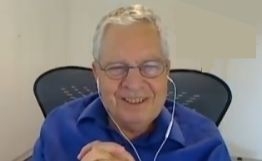News

Interview series with RILEM prominent members: Prof. Arnon Bentur
Prof. Arnon Bentur is Emeritus academic staff at the Civil and Environmental Engineering department of the Israel Institute of Technology in Haifa, Israel. Prof. Bentur served as TAC Chair between 2001 and 2004. He was then elected as Vice President in 2003 and took over the mandate as President in 2006. Prof. Bentur was also elected RILEM Fellow in 1998 and RILEM Honorary member in 2009. He chaired TC 181-EAS: Early age shrinkage induced stresses and cracking in cementitious systems and co-chaired TC 159-ETC: Engineering of the interfacial transition zone in cementitious composites. Prof. Bentur also chaired the RILEM Internal Workshop “Making RILEM more attractive” in 2006 in Madrid, Spain.
16 December 2021
RILEM Implementation Manager (RIM): Let’s start from the beginning. When did you join RILEM?
Prof. Arnon Bentur (AB): I think it was a couple of years after I completed my PhD and postdoc, in the early 80s.
RIM: Were you invited by a colleague to join RILEM?
AB: I knew RILEM because Prof. Rachel Shalon, who was the Director of the National Building Research Institute (at that time it was called the Building Research Station), was also President of RILEM. So, you know, RILEM was rooted in our Building Research Station where I started my career. Then my two supervisors at that time, Prof. Jaegerman and Prof. Soroka, were also very active RILEM members and they had very strong research connections, especially with people in Germany and in France. Their and my research activities at that time were related to concrete in a hot environment. Israel was doing a lot of construction around the 50s and 60s and 70s with the big waves of immigration to the country. We built public buildings, residential buildings, infrastructures. In Europe, the research of concrete in hot climate was not well developed because Europe does not have the hot climate we have.
RIM: So… you joined in the late 80s and in the 90s you became a RILEM fellow. What happened in that decade? You must have been very active!
AB: My main activity was in the Technical Committees. This is the best platform that RILEM has and where people have the opportunity to become active and develop their research interests and skills. So I started by being member of some TCs, and chaired TC 181-EAS and then co-chaired TC 159-ETC with Mark Alexander. Then I gradually became involved in the scientific management: how do you set up a committee? How do they perform? Then I joined TAC, and this was extremely interesting because this was the body in charge of creating new TCs, setting the rules on how TCs should work, trying to resolve issues between competing TCs. I have this recollection of two TCs on fracture mechanics. In those days, the structure was quite a hierarchy. You had a few very well-known professors running the TCs. I remember one professor who was the chair of one committee on fracture and another professor who was in another committee had very different views and models and ideas on the same matter. That was the kind of issues that sometimes we had to look at in TAC. At the same time, I was a committee member of ACI, and I could compare how committees worked in both associations. I could see the advantage of the technical committees in RILEM which were much more forthcoming in rapid promotion of new ideas, new technologies, and they were much more flexible. The technical nature of the committee work involved finding balance between science and engineering, which was a similar challenge as in the role of a faculty member in a technological university.
I was inspired by actions that were taken by Carmen and Åke (Editor’s note: Carmen Andrade, RILEM President in 2000-2003, and Åke Skarendhal, RILEM President in 2003-2006) that made very important changes in the organization. I continued in that line, to make more drastic changes in the management nature of RILEM and cooperated very intimately with my colleagues who later became RILEM presidents, Peter Richner, Mark Alexander and Johan Vyncke. We worked as a team and that was a very gratifying experience. In that process, which continued over several presidencies, we turned RILEM into a much more democratic organization which gave more room to the technical people to run the organization. The transition was a difficult period. The change into a new culture was not because the old culture was flawed, but because of the environment and the circumstances were changing.
When I was invited to this interview, I gave a thought about what to say. Going back to Prof. Shalon, she was a very active RILEM member and a strong and knowledgeable woman. I had a look at the history of RILEM. It was founded by the getting together of national building research institutes, which were public organizations. All of them had a mission, that is to make sure that, on a national level, the construction industry would fulfil its technological and social challenges. That was soon after the end of the second world war and the devastation it brought, especially upon Europe. What happened next was the need to do similar things in developing countries, gaining their independence after the colonial period in Asia and Africa. So RILEM was lead in many senses by 10-15 national research institutes, which resulted in RILEM having a very hierarchical nature; later on, the power of those pillars started to diminish as many universities became very strong centres in construction research. This change affected RILEM, and the organization had to adjust. Furthermore, in the old days you had the full professor who was sort of a “king”, and this had to change to look into getting young people to be involved in the committees with leadership roles. I remember my personal experience as a young postdoc in RILEM. It was basically the first time I was exposed to an international network of very knowledgeable people whom you had usually heard about and read their publications but now you sit next to them! This is an excellent platform. The discussions in the committees of RILEM are much more scientific and technological in nature compared to those in other organizations. Not that the others are “bad”, but have a different vision and mission.
RIM: Is it pure research?
AB: No, it is not! It is research and technology, and you dare to do more. For example, the STAR documents, which are the result of the work of a TC, can contain different views. It is not like the result of a standardization committee in which you have to come with a unique and single agreed upon version. Incorporating different views is a great advantage!
RIM: What is your view about the future involvement of less developed countries in RILEM? Do you think that RILEM will be able to attract more researchers from these parts of the world, in the same way it managed to move from a very rigid structure with a few national research centres to a very open and democratic organization?
AB: I think it is part of the main change that I was talking about previously, letting the technical people to run the organization. People sitting in the Bureau or General Council or with a role in making decisions are not representatives of countries any more. That was the case many years ago, and if you had a country representative, that person was usually “a big fish”. But when all TC chairs were admitted to the General Council (Editor’s note: nowadays, any RILEM member can sit in the General Council and vote) gradually everything changed, and this gave the opportunity for emerging talents from different countries to have a role in RILEM. One of the issues we experienced during those days was the need of resources to attend a meeting. With COVID 19 I experienced myself the possibility to use online meetings more comprehensively. This has somehow brought some positive aspects into our communication system, allowing also people without a budget to attend a RILEM meeting. And we also had a discussion about the membership fees that should differ from country to country (Editor’s note: RILEM applies a discount of 40% and 60% in the membership fees of members from countries with low and medium GDP per capita). When I was President, I remember that one of the things we did was to gradually diminish the role of the publication company of RILEM. We pushed for the publication to be online and to be accessible to all RILEM members. This was a kind of benefit that we could provide to members in developing countries. By doing so we thought to implement the synergy “you work for the organization, the organization gives benefits to you”. The big challenge was that by doing so we were losing some income, but we gained many more members and technical impact!
RIM: I think that in the last couple of years the majority if not all the TC meetings have been online. At the 75th RILEM Annual Week in Merida last September some of them were hybrid (online and in person).
AB: Yes, but you should be careful with that. From my experience of teaching at university, where we taught first fully online and then hybrid, I can say that the hybrid mode is not going very well. And I have also been in a couple of work meetings of this type. People tend to separate, in the sense that the interaction between the people that are physically present takes over those who are connected remotely.
RIM: The other side of the issue is that people are getting tired of online meetings and they long to meet in person again. Having only online TC meetings seems unfair.
AB: I do not have an answer for that, but perhaps it is in the development of some kind of rules or guidelines for the person that is chairing the hybrid meeting, to make sure that everyone gets the same opportunity to engage, that the meeting is not run only by the persons physically there.
RIM: What has been the impact of your work as a RILEM member?
AB: I think the greatest impact I had was in the committee I chaired with Mark Alexander, that dealt with interfaces. That is based on the need that you have to look into interfaces when you deal with composite materials, in terms of their mechanical properties but also durability issues. I think we had a great impact with regards to the glass fibre reinforced cement and composites of that kind, understanding that durability issues are not necessarily the result of a chemical-degradation process, but we have many durability issues that are, for example, associated with the interface getting denser, that can cause composites to turn from a ductile to a brittle material. Another noticeable impact was the result of a committee that was looking into cracking of cementitious materials. We investigated the benefits of adding fibres to control cracking. We looked into both, chemical and physical processes, but at the same time we tried to develop simple test methods that could be used to evaluate the performance of different systems and different fibres. One of the challenges was to reproduce in the laboratory the restraining conditions that cause the formation of a crack, which are the real site conditions. This has always been a characteristic of RILEM: to find the balance between basic science and the practice.
RIM: What is the most valuable of your papers in Materials and Structures?
AB: One of my papers I liked most was titled “Minimum cement content requirements: a must or a myth?” (Editor’s note: Wassermann, R., Katz, A. & Bentur, A. Minimum cement content requirements: a must or a myth?. Mater Struct 42, 973–982 (2009)). We were saying that from a technical point of view you would like to have as low as possible cement content, for mechanical and durability performances. In many standards the message is different, saying and resonating that a higher cement content than a certain minimum is beneficial; this was perhaps a necessity in the old period when admixtures were not around. We highlighted that nowadays you have so many admixtures that allows you to get workability with low cement content, but due to the minimum cement content requirements created in the past, in a period in which you didn’t have chemical admixtures, you cannot reduce it. This paper was impactful not in terms of citation but in the way it affected the way engineers and designers think about this.
RIM: One last question: where do you think RILEM should go?
AB: I think we should be going more towards systems than structures. The innovation nowadays is in the system and less in the structure. I compare our industry with the aeronautical industry. Take for instance the case of an airplane. The structure itself can be in service for 30, 40 even 50 years, but in the meantime you constantly change and update the engines, the navigation system, etc… I think we should look into this.
RIM: I said I would have taken only 30 minutes of your time and we have been talking for almost one hour. Thank you so much for your time!
AB: Very good! Thank you. Bye bye.














No comment
Log in to post comment. Log in.